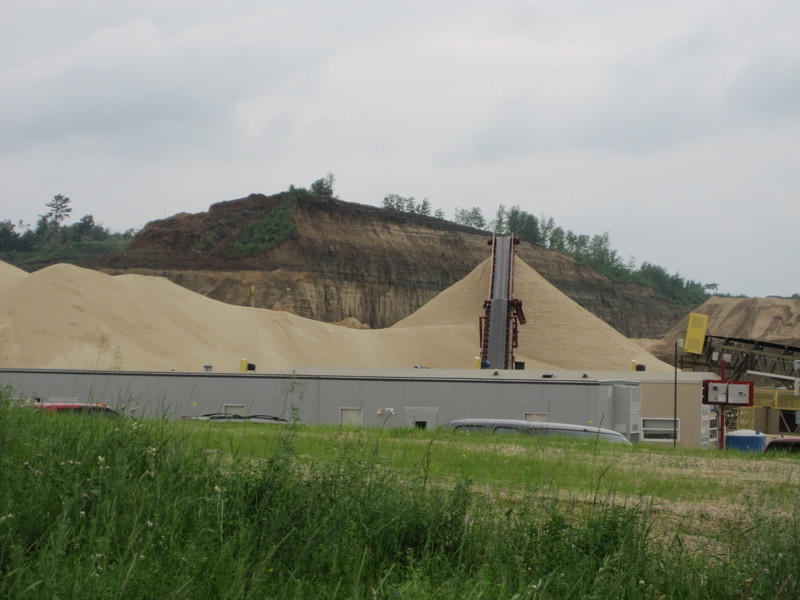
Background on Frac Sand
Introduction
Sand and gravel are mined for use in a variety of contexts, from concrete to glass production. Mining for aggregates such as sand and gravel is often accomplished through strip mining bedrock below soil layers. Miners displace everything above the target bedrock formation (e.g. soil and non-target rock formations), extract bedrock, and process it into gravel and sand through crushing and sifting. Sand is mostly comprised of crystalline silica, a hard mineral with high compressive strength. While particles of crushed silica, less than 50 microns ( 50μm, or millionths of a meter), are small enough to become airborne, silica’s high strength prevents it from fracturing small enough to become respirable unless under intense pressure. Under the high pressures of industrial processing, silica can be crushed smaller than 5 μm, the size at which it is carcinogenic when respired.
Silica & Health
Freshly crushed silica is hard and sharp. Respired silica can tear lung tissues, causing scarring and inflammation, to create a potentially fatal condition known as silicosis and other respiratory ailments. Workers at industrial sand mining operations and people living and working nearby may be exposed to respirable silica. While workers are covered by OSHA’s occupational exposure rules, respirable silica is largely unregulated beyond the facility’s fence, and is only considered by regulators through regulations on all airborne particles.
The Boom in Sand Mining
While industrial sand mining has occurred for more than a century, sand is increasingly in demand for use in oil and natural gas production. With the massive adoption of hydraulic fracturing and horizontal drilling in the U.S., round silica sand is needed as a ‘proppant,’ a material used to prop open oil and gas-bearing fissures while also allowing gas and oil to escape.
The production of sand used in hydraulic fracturing operations - “frac sand” - (“Frac” is considered by some to be the industry’s spelling) increased from ~6 million tons in 2007 to 54 million tons in 2014 (Bleiwas, 2015; USGS 2007). Frac sand must be highly uniform, able to withstand high pressure, and well-rounded. The primary source location for frac sand is the Great Lakes region, especially western Wisconsin, which produced nearly half of the domestic frac sand in recent years (Bleiwas, 2015). Western Wisconsin is home to Cambrian and Ordovician sandstone formations, created when the area was the beachfront of a great inland ocean ~540 to 360 million years ago. Now, shallow sandstone there is made of well-rounded sand grains. Additionally, Wisconsin is a prime location for sand mining because of its dense railway network easily allowing transport of frac sand to oil and gas production zones in Pennsylvania, North Dakota, the Gulf Coast and more.
Environmental Impacts of Sand Mining
Communities in western Wisconsin are faced with the impacts of industrial sand mining and processing for frac sand. the diverse environmental impacts include:
- light and noise pollution,
- damage to roads,
- increased truck traffic and diesel and dust from trucks,
- accelerated erosion and runoff,
- aquifer impacts from water-intense sand washing, and
- airborne silica.
Regulation and Monitoring of Sand mining
Wisconsin requires frac sand facilities and other nonmetallic mining operations to comply with air and water permits, but this does not usually include monitoring requirements. There is little data on industrial sand mining’s air and water quality impacts, and the data that does exist is contested. Most of the authority to accept or reject sand mining facilities, and emplace stipulations on their operations (such as hours, noise, and truck traffic) is held in the local government through ordinances. Concerned citizens in several counties have initiated research into the local impacts -- positive and negative -- of frac sand mining operations, and certain townships have passed local ordinances and licensing requirements.
Cited References
U.S. Geological Survey. 2013 (published 5/2015). Minerals Yearbook: Silica.
Wisconsin Department of Natural Resources. 2015. Industrial Sand Mining.
Additionally, an explanation of industrial sand mining process can be found on the Wisconsin Geologic & Natural History Survey website.


